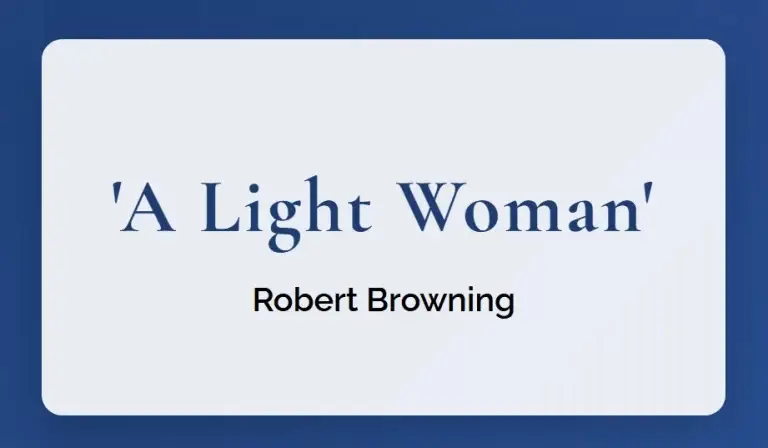Introduction: The Art of Moral Complexity
Robert Browning’s “A Light Woman” emerges as a masterpiece of psychological intrigue, where the intricate dance of desire, manipulation, and moral ambiguity unfolds through the lens of dramatic monologue. Like his contemporary Victorian poets who grappled with societal constraints and individual desires, Browning crafts a narrative that penetrates the veneer of moral certainty to expose the complex motivations that drive human behavior. For a deeper understanding of this literary context, explore our analysis of Victorian Poetry: A Comprehensive Guide.
Table of Contents
Poetic Architecture: Form and Function
Robert Browning’s mastery of dramatic monologue reaches its zenith in this work, where the very structure mirrors the psychological complexity of its narrator. Consider the opening stanza:
“So far as our story approaches the end, Which do you pity the most of us three?— My friend, or the mistress of my friend With her wanton eyes, or me?”
The ABAB rhyme scheme, characteristic of Robert Browning’s dramatic works, creates a deceptive simplicity that masks the poem’s deeper psychological currents. This technical choice reflects the narrator’s own carefully constructed facade of casual storytelling.
The Psychology of Characters
The Narrator: Architect of Destruction
The poem’s narrator embodies the Victorian crisis of moral authority. His role as both orchestrator and chronicler of events creates a fascinating double perspective, reminiscent of the complex narrators found in My Last Duchess Poem Overview. Through carefully chosen diction and strategic pauses, Browning reveals a character whose intellectual detachment masks deep emotional involvement:
“And I,—what I seem to my friend, you see, What I soon shall seem to his love, you guess.”
The Light Woman: Beyond the Stereotype
Robert Browning subverts the traditional Victorian “fallen woman” narrative by presenting the light woman not as a mere object of moral judgment, but as a complex agent in her own right. Consider these lines:
“With her wanton eyes, or me? So, friend of my heart, it ends.”
The description transcends simple physical attributes to suggest both agency and vulnerability, challenging readers to question their own moral assumptions.
Victorian Social Commentary
Browning’s poem serves as a sophisticated critique of Victorian social mores, particularly regarding:
- Male friendship and betrayal
- Female agency and societal judgment
- The performative nature of morality
- The intersection of desire and social responsibility
Technical Mastery and Innovation
Metrical Variations
The poem’s meter exhibits Robert Browning’s characteristic flexibility, employing:
- Strategic caesuras that create psychological tension
- Varied line lengths that mirror emotional states
- Enjambment that propels the narrative forward
- Stress patterns that emphasize moral ambiguity
Language and Imagery
Browning’s linguistic choices deserve careful attention:
“So weeks grew months, years; gleam by gleam The glory dropped from their youth and love”
This temporal compression, achieved through subtle accumulation of images, demonstrates Browning’s ability to convey complex emotional trajectories through precise poetic technique.
Modern Resonance
The poem’s exploration of moral relativism and psychological complexity continues to speak to contemporary readers. Its questions about friendship, loyalty, and the nature of desire remain startlingly relevant, while its technical innovations continue to influence modern poetry.
Conclusion: Beyond Moral Binaries
“A Light Woman” stands as a testament to Browning’s genius in crafting poems that resist simple moral interpretation. Through masterful use of dramatic monologue, sophisticated psychological insight, and technical innovation, Browning creates a work that continues to challenge and enlighten readers across generations.
How do you interpret the narrator’s true motivations? Share your analysis of this complex character in the comments below, considering both his actions and his careful choice of words.


